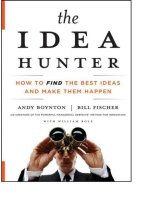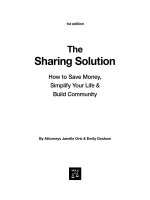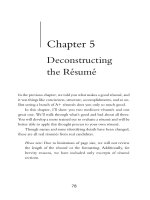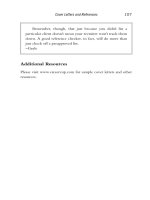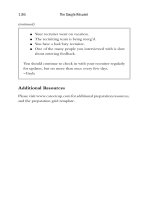The idea accelerator : how to solve problems faster using speed thinking.
Bạn đang xem bản rút gọn của tài liệu. Xem và tải ngay bản đầy đủ của tài liệu tại đây (5.11 MB, 160 trang )
KEN HUDSON
has a PhD in organi-
sational creativity. His thesis explored
the notion of ‘designing a continuously
creative organisation’.
Ken has also worked in senior roles for
over 15 years in marketing, advertising
and management consulting. He formed
his own Speed Thinking business called
The Speed Thinking Zone. Ken has worked with many
leading brands, including Heinz, Wrigley, Colgate, Kellogg’s,
Unilever, Disney, DuPont and Nestlé. He is the author of
The Idea Generator (Allen & Unwin, 2007).
Ken can be contacted at www.thespeedthinkingzone.com
ACCELERATOR
Bh1417M-PressProofs.indb iBh1417M-PressProofs.indb i 29/4/08 2:08:12 PM29/4/08 2:08:12 PM
Bh1417M-PressProofs.indb iiBh1417M-PressProofs.indb ii 29/4/08 2:08:13 PM29/4/08 2:08:13 PM
This page intentionally left blank
(OWåTOåSOLVEåPROBLEMSåFASTERå
USINGå3PEEDå4HINKING
+%.å(5$3/.
ACCELERATOR
Bh1417M-PressProofs.indb iiiBh1417M-PressProofs.indb iii 29/4/08 2:08:14 PM29/4/08 2:08:14 PM
First published in 2008
Copyright © Ken Hudson 2008
All rights reserved. No part of this book may be reproduced or
transmitted in any form or by any means, electronic or mechanical,
including photocopying, recording or by any information storage
and retrieval system, without prior permission in writing from the
publisher. The Australian Copyright Act 1968 (the Act) allows a
maximum of one chapter or 10 per cent of this book, whichever is
the greater, to be photocopied by any educational institution for
its educational purposes provided that the educational institution
(or body that administers it) has given a remuneration notice to
Copyright Agency Limited (CAL) under the Act.
Allen & Unwin
83 Alexander Street
Crows Nest NSW 2065
Australia
Phone: (61 2) 8425 0100
Fax: (61 2) 9906 2218
Email:
Web: www.allenandunwin.com
National Library of Australia
Cataloguing-in-Publication entry:
Hudson, Ken.
The idea accelerator : how to solve problems faster using speed thinking.
Bibliography.
ISBN: 978 1 74175 488 9 (pbk.)
Problem solving.
Creative thinking.
Creative ability in business.
650.1
Internal design by Kirby Stalgis
Set in 10/14 pt Berling by Bookhouse, Sydney
Printed in Australia by McPherson’s Printing Group
10 9 8 7 6 5 4 3 2 1
Bh1417P-Text.indd ivBh1417P-Text.indd iv 30/4/08 4:10:20 PM30/4/08 4:10:20 PM
contents
Introduction vii
1 Ten Speed Thinking tools you can use
with dramatic results 3
2 Ten Speed Thinking tools to use when
working with a colleague 25
3 Ten Speed Thinking tools to use when
working in a group 47
4
Ten Speed Thinking tools to build a
bigger idea 69
5
Ten Speed Thinking tools to help
evaluate an idea 91
6
Ten Speed Thinking tools to get started 113
Conclusion 135
Notes 139
Further reading 141
Bh1417M-PressProofs.indb vBh1417M-PressProofs.indb v 29/4/08 2:08:14 PM29/4/08 2:08:14 PM
In memory of Ray O’Neill, a man of big dreams and
Gloria O’Neill, a remarkable and courageous woman.
This book is dedicated to Margot, Molly and Charlotte
who in their own way make my heart beat faster.
I would also like to thank my publisher Ian Bowring for
supporting the concept and to my editors Karen Gee
and Angela Handley for making this book infinitely
better.
A special thank you to my agent Carolyn Crowther for
her unbridled enthusiasm.
Bh1417M-PressProofs.indb viBh1417M-PressProofs.indb vi 29/4/08 2:08:14 PM29/4/08 2:08:14 PM
introduction
Everywhere I go I hear the same lament—if only I had more
time. Time, not money, has become our most precious
resource. Not only is there less time in the day but there is
always more to do. And the pace of life seems to be increasing.
That weekend away at the beach always seems to beckon but
we never quite make it.
The premise of this book is that limited time is the new
reality for most people. It is the rule rather than the exception.
It is not a question of working harder—most people are
already stretched to the limit. Nor is it enough to be a better
time manager. We need a new approach and that is what this
book is all about.
Our new priority should be to improve the productivity of
our thinking—to generate greater results in a shorter period
of time. Until now, we have concentrated on improving the
return on physical assets (e.g. machinery). Increasingly, the
work of the future will be conceptual rather than physical.
We all must improve our thinking muscle. Immediate results
require faster, better thinking.
In a broadband-paced world the speed with which we process
information, create new solutions and make decisions has to
vii
Bh1417M-PressProofs.indb viiBh1417M-PressProofs.indb vii 29/4/08 2:08:14 PM29/4/08 2:08:14 PM
viii
the idea Accelerator
accelerate. To adapt to this new reality requires an entirely
n
ew style that I have called Speed Thinking. This type of
thinking, however, does not negate the importance of the
more conscious, deliberate, and reflective approach. Rather,
it complements it, much like Speed Chess resembles the
original but has its own distinct rules and flavour.
Fortunately we are very good at what Malcolm Gladwell
(among others) calls rapid cognition.
1
He calls it the ‘universal
ability of our unconscious to find patterns in situations and
behaviour based on very narrow slices of experiences’. As it
turns out we are also very adept at using our intuition to
make fast decisions under extreme pressure.
2
So the idea of
Speed Thinking has been around for a while, but what we
have lacked is a tool kit to help us improve upon this ability.
That is what this book aims to give you.
In my workshops I have found that accelerated thinking allows
you to access, almost at will, your amazing, creative mental
ability. Timothy D. Wilson calls this our Adaptive Unconscious,
which plays a major executive role in gathering information,
interpreting and evaluating it. It also sets goals in motion
quickly and efficiently.
3
I stumbled upon this universal ability almost by accident. To
create some urgency and drama in my creative workshops
I kept reducing the amount of time I gave participants to
solve a problem.
But a strange thing happened: the less time I gave people,
the more ideas they produced and, as importantly, the
originality of the ideas became more pronounced. In turn,
participants were amazed at what they could produce in such
a small period of time.
Bh1417M-PressProofs.indb viiiBh1417M-PressProofs.indb viii 29/4/08 2:08:14 PM29/4/08 2:08:14 PM
introduction
ix
Bypassing your two judges
In reflecting on why people can become more creative in a
shorter period of time I came to the conclusion that it is
because we all have what I call two judges—one internal,
the other external. It is these judges that suppress our natural
creative instincts.
The internal judge is our own (often) critical voice that warns
us our ideas may not be very good and that we are not creative.
This idea is reflected in the work of W. Timothy Gallwey,
who postulated that in sport and life we maintain a constant
dialogue between what he calls Self 1 (the commentator) and
Self 2 (the doer).
4
Self 1 not only gives instructions to Self 2
but criticises past errors, warns of possible future ones and
harangues whenever there is a mistake. I found this also
resonated with my experience. We are often the greatest critic
of our own ideas. Paradoxically, if we are only given a limited
amount of time we are forced to ignore our Self 1 and just
get our big, beautiful ideas out.
The other judge is the external one. It relates to our friends,
peers, colleagues and bosses. We are often so worried by
what they might say or how critical they can be that we
suppress our unconscious imagination and intuition. This
often leads to safe, incremental ideas and solutions. Sports
people, for example, know that worrying how others might
judge their performance can create a negative spiral. As the
Yankees’ third baseman and baseball’s highest paid player,
Alex Rodriguez responded when trying to explain his amazing
form: ‘I’m just trying to have as much fun as I can and really
not care about what people are thinking or saying.’
5
With
the Speed Thinking approach you literally have no time to
Bh1417M-PressProofs.indb ixBh1417M-PressProofs.indb ix 29/4/08 2:08:15 PM29/4/08 2:08:15 PM
x
the idea Accelerator
worry about what anyone else thinks. You are too busy
cr
eating.
The benefits of Speed Thinking
In the many workshops I have run using the tools in this
book participants have mentioned the benefits listed below.
Their usual response after a period of intense creativity is
‘Where did that come from?’
People are more focused
When people are given only a short time to develop a new
range of ideas they become incredibly focused. There is a
short burst of creative energy, and people become absorbed
in the here and now, which can often lead to a circuit-
breaking solution.
The approach leads to greater action
Paradoxically, giving people too much time to think can lead
to paralysis by analysis. Providing a short window of time
sometimes short-circuits this and creates more energy and
action.
The big elephants are tackled
This is a surprising result. I have observed that giving people
less time to tackle an issue means they have to address the
large issues rather than dwell on the periphery. This means
that meetings are often more productive and effective in half
the time.
The number of ideas is increased
The Speed Thinking approach emphasises working from the
individual up to the group. This means, for example, that if
Bh1417M-PressProofs.indb xBh1417M-PressProofs.indb x 29/4/08 2:08:15 PM29/4/08 2:08:15 PM
introduction
xi
ten people can create nine ideas each in 120 seconds then
you have 90 ideas in the time taken to eat a chocolate bar.
It can have a positive effect on your mood
Recent research by Emily Pronin and Daniel Wegner suggests
that the very process of thinking faster almost regardless of
the content could improve the way you feel.
6
Speed Thinking can be used by an individual or a group
The Speed Thinking tool kit can be used with great effect
by individuals, people working together and/or in a group.
The learning experience is profound
Just like the One Minute Manager technique, people can
undergo an important learning experience because the tools
are so practical and the effect is immediate.
7
The structure of Speed Thinking
This book outlines 60 Speed Thinking tools. There are six
chapters with ten tools in each chapter. Each tool is described
on one page and on the opposite page is an application or
example of the tool. There are chapters on how you can use
the tools when working alone, when working with a partner
or group and how to enhance, evaluate and action ideas
working at speed. The Conclusion then addresses some of the
most commonly asked questions about this type of
thinking.
The Speed Thinking tools can be learned by anyone, at any
level, regardless of their role or industry. You do not need a
university education to use this book. The tools are practical
and have been tested over a number of years. I have found,
Bh1417M-PressProofs.indb xiBh1417M-PressProofs.indb xi 29/4/08 2:08:15 PM29/4/08 2:08:15 PM
xii
the idea Accelerator
for example, that the optimum time to solve a problem using
t
his approach is 120 seconds with an ideal target of nine
responses. You may not reach this initially but with practice
and by using the tools in this book you can reach this goal.
Who this book is written for
This book will be of tremendous value to leaders, managers,
small business owners, consultants, coaches and university
students. Most of the examples are more business oriented
but the tools can be used for any application.
Bh1417M-PressProofs.indb xiiBh1417M-PressProofs.indb xii 29/4/08 2:08:15 PM29/4/08 2:08:15 PM
ACCELERATOR
Bh1417M-PressProofs.indb 1Bh1417M-PressProofs.indb 1 29/4/08 2:08:15 PM29/4/08 2:08:15 PM
‘Speed will help you bypass your
Censor.’
Mark Bryan, Julia Cameron and Catherine Allen,
The Artist’s Way at Work
Bh1417M-PressProofs.indb 2Bh1417M-PressProofs.indb 2 29/4/08 2:08:15 PM29/4/08 2:08:15 PM
Tool 1 The 120-second challenge 4
Tool 2 The two-hourly re-challenge 6
Tool 3 Breathe in—breathe out 8
Tool 4 The Richard Branson boost 10
Tool 5 A letter a day 12
Tool 6 The 60-second challenge 14
Tool 7 The five senses 16
Tool 8 ‘Thank you’ 18
Tool 9 Rapid drawing 20
Tool 10 Express emotions 22
Ten Speed Thinking
Tools you can use
with dramatic results
Bh1417M-PressProofs.indb 3Bh1417M-PressProofs.indb 3 29/4/08 2:08:16 PM29/4/08 2:08:16 PM
Ten Speed Thinking Tools
4
1
The 120-second challenge
Whatever problem you are working on, try to crystallise
it into one sentence or at most a paragraph.
Say the problem out loud to yourself. Then say ‘start’ or
‘go’ and give yourself 120 seconds to come up with as
many different solutions or new ideas as you can. You
should aim for at least nine. Just use a key word or an
image to capture the idea.
The emphasis is on producing as many different solutions
to the problem as you can. You will fi nd you will not
have time to evaluate if you want to get nine ideas down
on paper.
The simple process of concentrating on increasing the
number of ideas will decrease your rational, judging mind
and enable you to access your intuition and imagination.
An extension of this tool is to think of nine radical ideas
in 120 seconds. Do not be safe or incremental in your
responses.
Bh1417M-PressProofs.indb 4Bh1417M-PressProofs.indb 4 29/4/08 2:08:16 PM29/4/08 2:08:16 PM
you can use with dramatic results
5
Application
The challenge: How can I ensure I arrive on time to all my
appointments?
As quickly as you can in the next 120 seconds try to write
down at least nine ways of meeting the above challenge—below
is an example.
Now select and test the best ones.
Put watch
forward
Leave earlier
Only schedule
morning
meetings
Use a stop
watch
Have a watch
on each hand
Keep a clock in
every room
Send warnings
to myself
Have friends
warn me
Change other
people’s
watches
Bh1417M-PressProofs.indb 5Bh1417M-PressProofs.indb 5 29/4/08 2:08:16 PM29/4/08 2:08:16 PM
Ten Speed Thinking Tools
6
The two-hourly re-challenge
The aim with this tool is to concentrate on one problem
for the entire day.
Clarify the problem at the start of the day and take up
the 120-second challenge, aiming to develop at least
nine responses. Be sure to record the results.
Then move on to your other work. In two hours return
to the original problem.
Allow yourself another 120 seconds to develop a new
set of solutions.
There is only one rule: you must not repeat an idea.
This cycle should be repeated every two hours until
you have at least 40 different ideas.
Then select the best ideas and try to test these quickly,
easily and simply.
2
Bh1417M-PressProofs.indb 6Bh1417M-PressProofs.indb 6 29/4/08 2:08:16 PM29/4/08 2:08:16 PM
you can use with dramatic results
7
Application
Focus on one problem for the entire day. Develop fi ve possible
solutions every two hours. At the end of the day select the
most original response and test it.
The problem:
Date:
First two hours
1
2
3
4
5
Second two hours
1
2
3
4
5
Third two hours
1
2
3
4
5
Fourth two hours
1
2
3
4
5
Bh1417M-PressProofs.indb 7Bh1417M-PressProofs.indb 7 29/4/08 2:08:17 PM29/4/08 2:08:17 PM
Ten Speed Thinking Tools
8
Breathe in—breathe out
Concentrate all your mental energy on a specific
problem.
Now close your eyes and really focus on your breath. Slow
your breathing down and feel your chest move in and out.
Take two big breaths and open your eyes before you
start.
On the third exhalation try to think of a new solution.
Just write down one key thought.
From then on try to create a new idea with every second
exhalation.
Try to do this for ten breaths and you will have fi ve new
ideas. This is also a very good tool to use with a partner
as you take it in turns to solve a problem.
The important point with this exercise is for the breath
to be calm and long, not shallow and short. This exercise
will help to clear your mind and will often lower your
stress levels.
3
Bh1417M-PressProofs.indb 8Bh1417M-PressProofs.indb 8 29/4/08 2:08:17 PM29/4/08 2:08:17 PM
you can use with dramatic results
9
Application
The challenge:
Breath one: Key thought:
Breath two: Key thought:
Breath three: Key thought:
Breath four: Key thought:
Breath five: Key thought:
Now select the best option and test it.
Bh1417M-PressProofs.indb 9Bh1417M-PressProofs.indb 9 29/4/08 2:08:17 PM29/4/08 2:08:17 PM
Ten Speed Thinking Tools
10
The Richard Branson boost
The concept behind this tool is for you to imagine yourself
as someone who is renowned for their creativity or
entrepreneurship.
Let’s select Sir Richard Branson as an example, the founder
of the Virgin group of companies. Select a problem and in
120 seconds you have to imagine how he might solve the
problem. Remember you need at least nine solutions.
The next time you do this you can imagine how another
person might solve the problem: it could be your boss,
Oprah Winfrey or Albert Einstein.
Then try to play around with your ideas. Combine ideas
number three and fi ve, for instance, to create an even
bigger idea. Or focus on developing one option selected
at random, e.g. idea number seven.
4
Bh1417M-PressProofs.indb 10Bh1417M-PressProofs.indb 10 29/4/08 2:08:17 PM29/4/08 2:08:17 PM
you can use with dramatic results
11
Application
The challenge: How can I kick-start my career?
As quickly as you can in the next 120 seconds imagine Richard
Branson as your coach. What would he advise? Here are some
sample ideas.
Look outside
of your industry
Go back to
university
Open your own
business
Look for a gap in
the market
Talk to high-
performing
people
Take on a risky
project
Move out of
your comfort
zone
Find people
with money
to back you
Be noticed
Now select the best option and test it.
Bh1417M-PressProofs.indb 11Bh1417M-PressProofs.indb 11 29/4/08 2:08:17 PM29/4/08 2:08:17 PM
Ten Speed Thinking Tools
12
A letter a day
The aim in this tool is to use a letter of the alphabet to
help you solve a problem.
Make Monday the letter ‘A’ day, Tuesday the letter ‘B’ day,
and so on.
1
After defi ning the problem try to think of as many different
ways you can solve it using the letter ‘A’ in the next 120
seconds.
This is a very good tool to use when you are facing a
particularly diffi cult problem and you feel stuck. It is also
a good tool to use with a partner. Both work on the same
problem for 120 seconds but you use the letter ‘A’, for
example, and your partner must use the letter ‘B’. The
results may surprise you both.
5
Bh1417M-PressProofs.indb 12Bh1417M-PressProofs.indb 12 29/4/08 2:08:18 PM29/4/08 2:08:18 PM
you can use with dramatic results
13
Application
The challenge: How can I better manage my work–life balance?
As quickly as you can in the next 120 seconds try to create
at least nine different possibilities using the letter ‘A’.
Argue with my
boss when he/she
is making unfair
demands
Acknowledge
others who are
trying to lead a
more balanced life
Arrange meetings
while commuting
Apple a day
(i.e. watch my
diet)
Apply time
management
principles
Always say no to
weekend work
Assign work
to others
Applaud
(i.e. go and watch
sport/live music)
Appreciate
(i.e. time with
family)
Now select the best option and test it.
Bh1417M-PressProofs.indb 13Bh1417M-PressProofs.indb 13 29/4/08 2:08:18 PM29/4/08 2:08:18 PM

